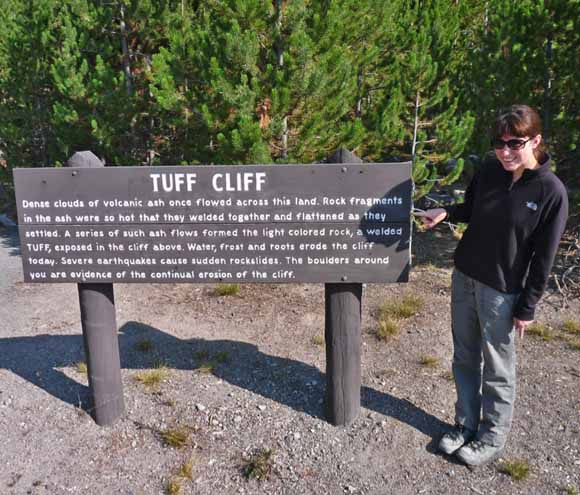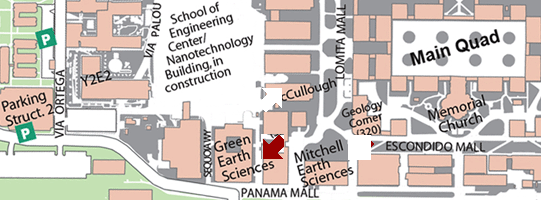
Presents
Location: Stanford University
This will be the 434th meeting since 1954

Naomi sampling Bishop Tuff pumice, Long Valley
The quantification of timescales of assembly, storage and evolution of rhyolitic magma is essential for understanding processes operating at active volcanoes. The Inyo Domes rhyolitic chain, which erupted at ca. 1350 CE from a fissure near the northern boundary of Long Valley caldera, California, provides an example of rhyolitic mush that has been episodically tapped over an interval of hundreds of thousands of years. Our new ion microprobe data reveal that the mixed magmas each have unique crystallization histories with varying residence times but also exhibit evidence for final mixing within a hundred years of final eruption. In order to evaluate the timing of crystallization and history of rejuvenation, we present 238U-230Th zircon geochronology coupled with geospeedometry from trace-element zoning data for crystals extracted from the Inyo Domes and older related rhyolite. The Inyo domes display complex magma mixing features, involving a coarsely-porphyritic and finely-porphyritic rhyolite which are distinct in their mineralogy, chemistry and textures. The coarsely-porphyritic lava is similar in texture and mineralogy to the ~100 ka Deer Mountain rhyolite, situated to the south of the Inyo chain. In contrast, the finely-porphyritic lava may relate to magma sourced in the Mono chain to the north of the caldera. Deer Mountain zircons have rims that grew immediately prior to eruption (~100 ka) and cores that are significantly older (~250 ka), providing evidence for zircon growth during protracted evolution of the mush body. South Deadman Dome coarsely-porphyritic rhyolite contains three populations of zircon, with apparent populations of ~30 ka, ~100 ka, and >200 ka, the latter two correlating to populations sampled by the earlier Deer Mountain eruption. Zircons extracted from finely-porphyritic rhyolite return near-eruption ages (<1 ka) and do not contain evidence for an older zircon population, suggesting that it was not sourced from Inyo mush, but more likely from Mono magma to the north. To reconstruct the history of the repeatedly sampled mush, sanidine phenocrysts were evaluated for geospeedometry (a technique which relies on the kinetic smearing of compositional zoning in crystals by diffusion over time). Individual sanidines are strongly zoned in cathodoluminescence and contain complex xenocrystic cores and multiple resorption horizons. Trace and minor element transects from core to rim of individual phenocrysts display abrupt compositional changes at zone boundaries. Binary element diffusion modeling (BEDM) using Sr and Ba yields diffusion ages on the order of months to years for the outer rim zone boundaries, providing constraints on the timescales of rejuvenation of the crystal mush prior to or during contact with the younger crystal-poor magma.

Naomi Matthews
Dr. Matthews received her BSc(Hons) from the University of Canterbury, New Zealand, and her PhD from the University of Oxford, United Kingdom. Naomi is currently a Postdoctoral Fellow at the U.S. Geological Survey, and a visiting scholar at Stanford. Naomi studied the petrography and geochemistry of plutonic lithics from the Rotoiti Ignimbrite (Taupo Volcanic Zone, NZ) for her Honours thesis, with the aim to reconstruct links between the plutonic and volcanic realms. For her PhD she investigated magma reservoir processes associated with the ~340 ka Whakamaru supereruption (also Taupo Volcanic Zone, NZ), using a variety of crystal-specific analytical techniques. She also worked on the Younger Toba Tuff supereruption, investigating distal ash deposits in India and modeling tephra dispersal, in addition to being involved in reconstructing tephra dispersal during the 2007 Chaitén eruption, Chile. Her current work is focusing on ion microprobe U-Th-Pb geochronology of zircon and diffusion modeling of sanidine crystals, applied to Long Valley (Inyo Domes) and Yellowstone (Lava Creek Tuff). Naomi is particularly interested in the processes associated with silicic magma accumulation, storage and evolution at caldera volcanoes and the associated timescales.
Hot off the Press: Doris’ new book—Cooking Up a... Catering Business—is back from the printer and she’ll have copies you can buy ($25 plus tax); we can ask her to autograph them for us. You had the dinner; now read the book!
Reservations: The preferred way to make reservations is simply to email Mike Diggles at mdiggles@usgs.gov by Oct. 7, tell him you will attend, commit to pay, and bring your payment to the meeting. Mike always emails a confirmation; if you don’t get one, assume email crashed yet again and email him a second time. A check made to “PGS” is preferred, payable at the meeting.
If you want to pay in advance:
Everyone (including Stanford folks now) Please make dinner reservations by Oct. 7. Contact Mike Diggles, at U.S. Geological Survey, 345 Middlefield Road, MS-951 Menlo Park, CA 94025, Tel.: (650) 329-5404. Send check made out to “PGS” to Mike.
Dinner and the social hour is $35.00; this includes $5 that we use to help pay for students who are only $8.00 (also partially subsidized thanks to the School of Earth Sciences, Stanford University (Note, no-show reservations owe the full price).
Doris, whose wonderful crew prepares our meals, asked that we let you know that people who are late RSVPing and people who show up without a reservation will be welcome but that they will be eating on paper plates with plastic utensils (food supply permitting).
Dues for Academic Year 2012-2013 ($10.00) should be sent to Mike Diggles, U.S. Geological Survey, 345 Middlefield Road, MS-951, Menlo Park, CA 94025. Mike’s phone: (650) 329-5404.
Officers: Joe Colgan, President; Mike Diggles, Secretary-Treasurer; Elizabeth Miller, PGS Stanford University Coordinator

Date created: October 1, 2012
Last modified: October 2, 2012
Created by: Mike Diggles, Webmaster-Secretary-Treasurer, PGS.